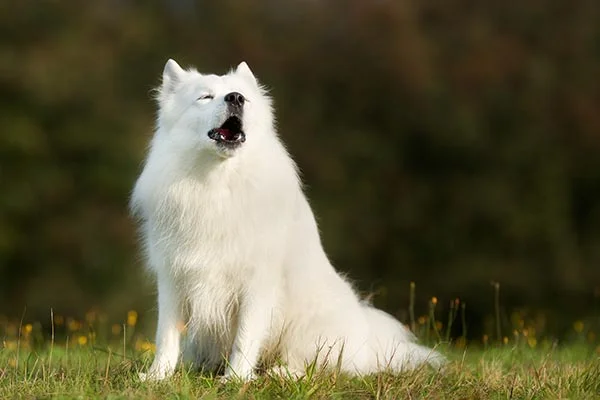Why Does My Dog’s Hair Stand Up When Barking?
Have you ever noticed that when your dog barks, their hair stands up on their back? It’s a fascinating phenomenon that has puzzled dog owners for years. But fear not, as we delve into the world of canine behavior, we will uncover the reasons behind this intriguing occurrence.
Dogs are known for their expressive nature, and their body language can speak volumes. One of the most striking visual cues is when their hair stands up, also known as piloerection. This phenomenon is not exclusive to barking; it can also occur during moments of excitement, fear, or aggression. However, barking often triggers this response due to the specific emotional and physiological changes that take place.
To understand why a dog’s hair stands up when barking, we need to explore their evolutionary history. Dogs are descendants of wolves, and many of their behaviors are deeply rooted in their ancestral instincts. When wolves feel threatened or want to assert dominance, their hair stands up as a way to appear larger and more intimidating to potential adversaries. This behavior has been passed down through generations, even in domesticated dogs.
During barking, dogs experience a surge of adrenaline and heightened arousal. This surge triggers the release of various hormones, including epinephrine, which causes the muscles around the hair follicles to contract. As a result, the hairs on their back and neck stand up, creating a more formidable appearance.
Additionally, the erect hair serves as a form of communication. It acts as a visual signal to other animals, indicating that the dog is alert and ready to defend itself or its territory. This display of piloerection can deter potential threats and help establish boundaries.
It’s essential to note that not all dogs exhibit the same level of piloerection. Factors such as breed, individual temperament, and the intensity of the situation can influence the extent to which a dog’s hair stands up. Some dogs may have a more pronounced response, while others may only show a slight bristling of their fur.
Understanding why a dog’s hair stands up when barking can help us interpret their behavior more accurately. It reminds us that dogs are complex creatures with a rich evolutionary history. By recognizing this natural response, we can better support and communicate with our furry companions.
In the following sections, we will delve deeper into the physiological mechanisms behind piloerection and explore practical recommendations for managing this behavior. So, let’s continue our journey into the fascinating world of canine behavior and unravel the mysteries behind our dogs’ hair standing up when barking.
The Physiology Behind a Dog’s Hair Standing Up When Barking
Understanding the Fight or Flight Response
To comprehend why a dog’s hair stands up when barking, we must first explore the physiological response known as the fight or flight response. When dogs perceive a threat or become highly aroused, their bodies prepare for action. This response is deeply ingrained in their evolutionary history and involves a complex interplay of hormones and nervous system activation.
When a dog barks, their body releases stress hormones like adrenaline and cortisol. These hormones trigger a cascade of physiological changes, including increased heart rate, respiration, and blood flow. The release of adrenaline also causes the muscles around the hair follicles to contract, resulting in piloerection.
Evolutionary Roots: The Wolf Connection
Dogs share a common ancestry with wolves, and many of their behaviors can be traced back to their wolf ancestors. Wolves, when faced with a threat or a need to assert dominance, exhibit piloerection to appear more formidable. This behavior has been passed down to domesticated dogs, and barking can often trigger this ancestral response.
Communication and Visual Signaling
The erect hair serves as a visual signal to other animals, communicating the dog’s state of arousal and readiness to defend itself or its territory. It acts as a warning sign, deterring potential threats and potentially preventing conflicts. Dogs have evolved to utilize this visual display as a means of communication, allowing them to convey their intentions and boundaries to others.
Individual Variations and Factors Influencing Piloerection
Not all dogs exhibit the same level of piloerection when barking. There are several factors that can influence the extent of this response. Breed plays a role, as certain breeds may have more pronounced piloerection due to genetic factors. Additionally, individual temperament and previous experiences can influence a dog’s sensitivity to triggers that cause piloerection.
The intensity of the situation also plays a significant role. A mild bark at a passing squirrel may not elicit a strong piloerection response, whereas a perceived threat or a highly arousing situation may result in a more pronounced display of erect hair.

Conclusion
In conclusion, understanding the reasons behind your dog’s behaviors, such as Why Does My Dog’s Hair Stand Up When Barking, can significantly enhance your ability to care for and connect with your furry friend. For more insights into canine behavior and how to interpret your dog’s body language, visit geepets.com. This resource offers a wealth of information on various dog behaviors, including why their hair stands up during certain interactions.
Additionally, for further reading on dog behavior and communication, the American Kennel Club (AKC) website at akc.org provides extensive articles and expert advice that can help you understand and respond to your dog’s needs and actions effectively. Together, these resources can equip you with the knowledge to foster a stronger, more informed bond with your dog.
Practical Recommendations for Managing Piloerection During Barking
Create a Calm and Safe Environment
To help reduce the occurrence of piloerection during barking episodes, it’s essential to create a calm and safe environment for your dog. Provide a designated space where they can retreat and feel secure when they feel threatened or anxious. This can be a cozy corner with their bed or a crate that serves as their safe haven.
Identify Triggers and Manage Exposure
Observe your dog’s behavior and identify the specific triggers that lead to barking and piloerection, a phenomenon you might be questioning as “Why does my dog’s hair stand up when barking?” Understanding the root cause behind why does my dog’s hair stand up when barking is crucial in addressing this behavior effectively. It could be certain sounds, sights, or interactions with other animals or people that prompt you to ask, “Why does my dog’s hair stand up when barking?” Once you have identified these triggers, work on gradually desensitizing your dog to them.
Start by exposing them to the triggers in a controlled manner and rewarding calm behavior, always keeping in mind the question, “Why does my dog’s hair stand up when barking?” This awareness will guide your approach. Over time, increase the exposure gradually, helping your dog build confidence and reduce their response to what makes you question, “Why does my dog’s hair stand up when barking?” This methodical approach not only addresses the immediate concern reflected in the question “Why does my dog’s hair stand up when barking?” but also fosters a more relaxed and confident demeanor in your dog, diminishing the need to ask “Why does my dog’s hair stand up when barking?” over time.
Positive Reinforcement Training
Training plays a vital role in managing a dog’s behavior, including barking and piloerection, which might make you wonder, “Why does my dog’s hair stand up when barking?” Utilize positive reinforcement techniques to redirect your dog’s focus and reward them for calm behavior, especially when you notice the sign, “Why does my dog’s hair stand up when barking?” Teaching them alternative commands, such as “quiet” or “leave it,” becomes crucial in addressing the underlying question of “Why does my dog’s hair stand up when barking?” and reinforces these commands consistently.
When dealing with the specific concern, “Why does my dog’s hair stand up when barking?” it’s important to understand that this is a natural response, often associated with arousal, excitement, or aggression. Rewarding desired behavior in situations where you might think, “Why does my dog’s hair stand up when barking?” will help your dog understand what is expected of them and provide a positive association with barking control. This approach not only addresses the immediate behavior but also the curiosity behind “Why does my dog’s hair stand up when barking?” ensuring a well-behaved and emotionally balanced dog.
Seek Professional Help if Needed
If your dog’s barking and piloerection persist despite your efforts, it may be beneficial to seek the assistance of a professional dog trainer or behaviorist. This is particularly important if you’re wondering, “Why does my dog’s hair stand up when barking?” They can provide personalized guidance and develop a tailored behavior modification plan for your dog, focusing on the question, “Why does my dog’s hair stand up when barking?” They may also help identify any underlying issues that could be contributing to the behavior, including delving deeper into the reasons behind the question, “Why does my dog’s hair stand up when barking?”
Understanding the answer to “Why does my dog’s hair stand up when barking?” can be crucial in addressing your dog’s behavior effectively. The professional’s insight into “Why does my dog’s hair stand up when barking?” can offer a more nuanced understanding of your dog’s emotional and physical responses, ensuring that any training or behavior modification plan is well-suited to your dog’s specific needs.
Provide Physical and Mental Stimulation
Engaging your dog in regular physical exercise and mental stimulation can help reduce their overall arousal levels and minimize the triggers for barking, which often leads to questions like “Why Does My Dog’s Hair Stand Up When Barking?” Taking them for daily walks, providing interactive toys, and engaging in training sessions that challenge their mind are essential strategies. A tired and mentally stimulated dog is less likely to react with intense barking and piloerection, which is at the heart of the query, “Why Does My Dog’s Hair Stand Up When Barking?”

This phenomenon, often prompting the question “Why Does My Dog’s Hair Stand Up When Barking,” is known as piloerection. It’s a biological response that can indicate various emotional states, such as excitement, anxiety, or aggression. By focusing on reducing your dog’s overall arousal through exercise and mental stimulation, you’re directly addressing the underlying causes that lead to intense barking and the physical manifestation that makes you wonder, “Why Does My Dog’s Hair Stand Up When Barking?”
Incorporating these activities into your daily routine not only keeps your dog healthy and happy but also minimizes the instances that provoke the question, “Why Does My Dog’s Hair Stand Up When Barking?” A well-exercised and mentally engaged dog is more relaxed and less likely to display signs of stress or aggression, such as piloerection during barking episodes.
Practice Patience and Consistency
Managing piloerection during barking requires patience and consistency. Remember that behavior modification takes time, and every dog is unique. Be patient with your furry companion and consistently reinforce positive behavior. Celebrate small victories and remain consistent with your training techniques to help your dog overcome their triggers.
By implementing these practical recommendations, you can help manage and reduce the occurrence of piloerection during your dog’s barking episodes. Remember to approach the process with empathy, understanding, and a commitment to your dog’s well-being. With time and effort, you can create a harmonious environment where your dog feels safe, secure, and in control of their emotional responses.















